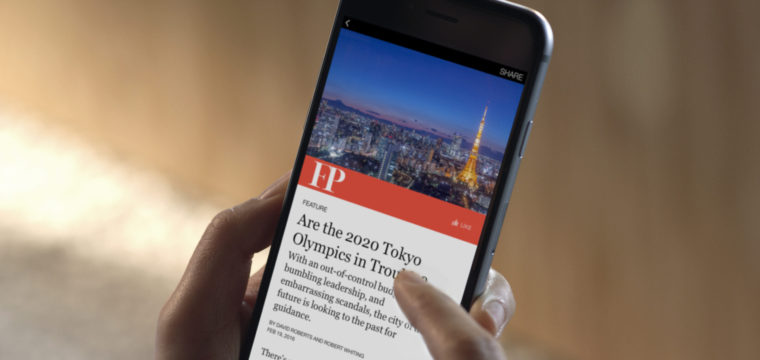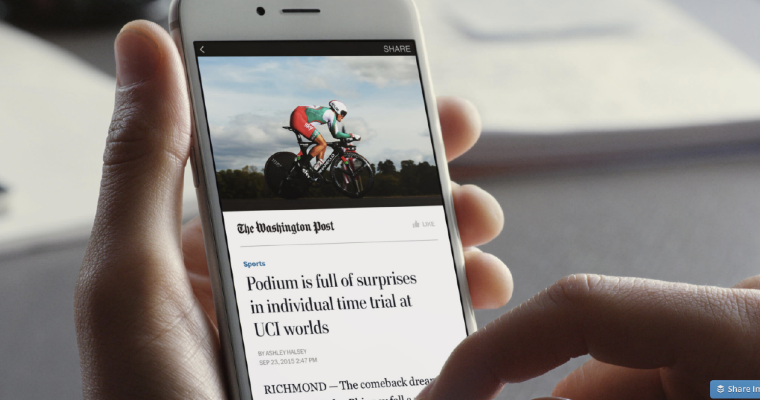In case you’re feeling out of the loop when it comes to all the fuss surrounding Instant Articles in recent weeks, let’s get you caught up. At its essence, Instant Articles is a distribution platform that allows publishers to distribute their content as native media within Facebook’s mobile app.
Last spring, Facebook launched a pilot of the platform with a select few premium partner publishers, which included The New York Times, BuzzFeed and The Atlantic. And as of last month, the platform is available to everyone. Instant Articles allow you to share content just like you would on your own website – but with interactive elements designed to enhance the mobile viewing experience. The content is accessible to Facebook users on Android and iPhone.
Best of Times or Worst of Times?
Facebook is adamant that Instant Articles are better for publishers because they’re better for end users, simply because they take far less time to display on audience members’ screens – up to 10 times faster than your own hosted mobile website. Instant Articles are HTML 5 documents are optimized for quick rendering using Facebook’s technology.
Publishers, on the other hand, are unsure. Many are wary of the platform and understandably so. There are fears over the pitfalls associated with “digital sharecropping,” increasing your business’s dependency on someone else’s property. Content professionals have been burned in the past by changes in Facebook’s algorithm causing organic reach and Facebook referral traffic to plummet, so there’s little justification to view Zuck and company as a strategic partner.
There’s also plenty of uncertainty across the media industry surrounding the viability of monetization models in the age of desktop browser ad blocking and mobile advertising’s transparency woes.
Depending on what you’re aiming to accomplish with your content, Instant Articles may be a viable solution for you. If you’re in the publishing business, your content – not your website – is your product, so it’s easy to argue that distributing your product and resonating with relevant people is your primary goal, regardless of who owns the platform you use.
Trying the Platform on for Size
Perhaps it’s time to let go of your digital sharecropping stigmas and start viewing your content as a fully detachable asset. Perhaps you don’t need to focus on driving traffic to a fully owned media property. The Instant Articles platform is relatively easy to experiment with, too, so you don’t need to fully commit to try it out.
A WordPress plugin is available to help streamline uploads and improve workflow efficiency. And if you’re using Drupal, there’s an integrated solution available for you too. Once you take care of basic setup as a one-time requirement, it’s possible to automate Instant Article production directly from your content management system. Facebook’s own tools also allow publishers to preview Instant Articles-powered content, to track the performance of all the items in your publishing feed and to edit content manually.
So despite all the arguments to avoid Instant Articles like the plague, there are some compelling reasons to give it a shot and see how well it serves your goals as a content producer. Here are six of the most enticing benefits that Facebook’s Instant Articles platform has to offer.
1. Faster Load Times Mean Better Audience Experiences
Loading time is critical to user experience, with data indicating that even a single second delay can cause up to a 7% loss in conversions. When the content we want doesn’t appear on our small screens within seconds, we lose patience and bounce.
Since Instant Articles are optimized and load within the app rather than on the standard mobile web, they render up to ten times faster, making it easier for readers to view, enjoy and share. Views and shares are critical to any social media-based content distribution efforts, after all, so technology that helps improve those metrics is useful. Facebook reports that Instant Articles have 70% lower bounce rates and 30% higher share rates than standard mobile web articles.
2. You Can Monetize With the Platform
Facebook allows publishers to sell and serve their own display and rich media ads, while keeping 100% of the revenue. Publishers also have the option to display ads from the Facebook Audience Network, to help monetize any unsold inventory. With this option, the publisher keeps 70% of the revenues and gives Facebook a 30% taste.

Facebook’s overall growth is fueled by mobile ads, which accounts for some 78% of the company’s ad revenue and 74% of their total revenue. So there’s a solid chance they’ll do a good job of profiting from the content you distribute on Instant Articles, and you’ll be in the position to make at least twice what they do from each ad tap.
3. A Proven Content Discovery Network
People are already using Facebook more than any other channel to find content to consume, so there’s no doubt that the platform can deliver audience members – if they are motivated to do so.
There are even signs that Instant Articles can get people interested in exploring the content on your site better than organic Facebook Page posts can. Facebook’s data shows the Instant Articles format translates to 20% higher click-through rates on links inside content than other mobile publishing formats.
4. Control Over Branding
Publishers have decent if not complete control of content experience branding options with Instant Articles. You can adjust colors and fonts and even include logos and other embedded media. So even though the publishing platform doesn’t have the branding versatility of your own property, the control you have here is far greater than what you have on LinkedIn Pulse or even Medium, for example.
This creates a more powerfully branded experience for your audience, which is important for memorability. When you consider that the majority of people are better at remembering what we see than what we hear, your brand’s visual appearance is extremely important. However, memory improves if we see and hear something, so the additional audio and visual features help to drive memorability home.
5. Integrations With Measurement Tools
With Instant Articles, publishers can still measure page views through a variety of analytics tools, including comScore, Chartbeat, Google Analytics, Omniture, and Adobe Analytics. If you integrate your reporting data properly, you’ll be able to track content paths to conversion from a single dashboard, regardless of if the content in question is on Instant Articles or your own website. You can also use a third-party tool to create a custom dashboard for tracking Instant Articles performance alongside metrics from any number of other platforms.
Tools like ShareThis make it possible to split test Instant Articles headlines. This way, you can still keep an eye on which types of content are resonating most with your audience, to continually drive traffic and draw in additional readers.
6. Immersive Full-Screen Experience
Mobile-only usage is increasing, and 30% of Facebook’s active users access the network solely using their phones. With the full-screen content experience of Instant Articles, publishers have more control over what mobile users see and do. Here Facebook seems to be taking a cue from Snapchat, where users are known to opt for faster consumption and the undivided attention demanded by full-screen video posts.


The richer content experience of Instant Articles, moreover, aims to better serve readers with a variety of features, such as auto-play video, embedded audio captions, tilt-to-pan photos and interactive maps.
The Game has Changed
Facebook’s Instant Articles platform definitely shows promise. Time will tell how publishers are affected by this rollout, and there are plenty of reasons to be wary.
On the other hand, there are some compelling reasons to consider trying out Instant Articles as a mobile-optimized, socially integrated solution for content distribution and monetization. And it’s easy enough to automate some experiments with the platform with minimal onboarding friction, so if you consider yourself to be a relatively brave and cunning content marketer, why not give it a shot and compare performance with your onsite assets?
Have you taken the plunge and already tried out Instant Articles? What have you learned about the platform so far? Let us know in the comments!
Image Credits
Featured Image: Image from Facebook Instant Articles Press Kit. Used with permission.
In-post Photos: All images from Facebook Instant Articles Press Kit. Used with permission.


